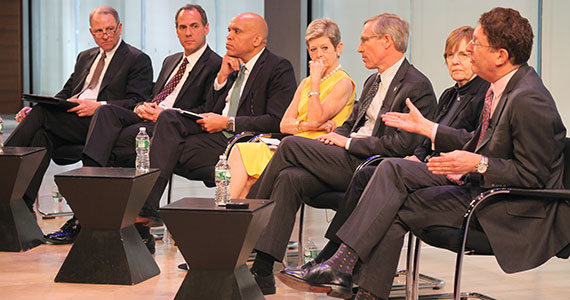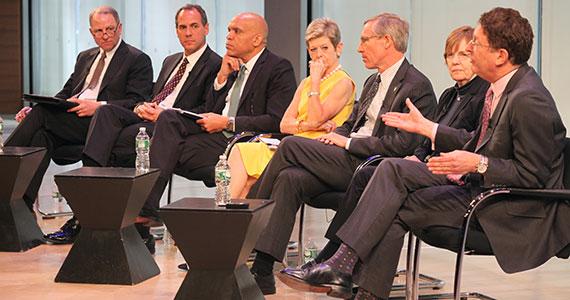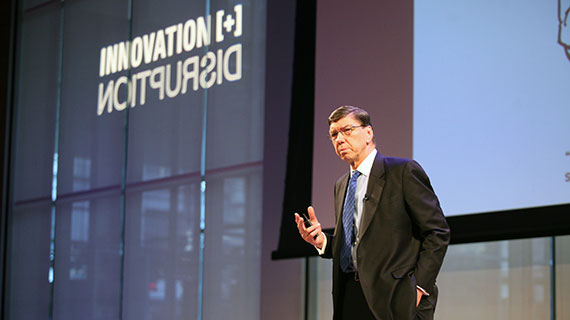
Jeff Fager ’77 (left), chairman of CBS News, moderates the panel discussion at The TimesCenter. (Photo by Lorenzo Ciniglio)
After Clayton Christensen predicted that half of higher education institutions will either be facing bankruptcy or in liquidation within 10 to 15 years, six liberal arts presidents expressed varying degrees of concern, ranging from “not worried” (Georgia Nugent, president emeritus of Kenyon College) to “only the paranoid survive” (Colgate President Jeffrey Herbst).
Christensen, author of The Innovator’s Dilemma and cofounder of the consulting firm Innosight, delivered the keynote address at the Innovation + Disruption in Higher Education symposium, hosted by Colgate University at the TimesCenter in New York City.
While moderator Jeff Fager ’77, chairman of CBS News, did his best to draw out opposing views, the panelists agreed more than they disagreed — especially with the idea that the relational experience of living on a liberal arts campus will never be replicated or bettered online.
Adam Falk, president of Williams College, is encouraged by the ways faculty can “use technology to deepen the social dimensions of the work they do with students.” He said that “location-based accidents,” such as a physics major who happens to room with an art major, can only happen in a physical community, and that it is necessary for students to engage with faculty and with each other for material to take hold.
“It is in the process of engaging with the thing that we are engaging, whether it is Stendahl, or whether it is chemistry, or whether it is Buddhism…that builds our minds.”
David Oxtoby, president of Pomona College, also pointed to students’ influences on each other and the formation of mentoring relationships. “Liberal arts colleges are disruptive force in education,” he said. He predicted that by 2025 there will be more courses co-taught between disciplines, and more that keep alumni engaged throughout their careers.
MORE
- Watch the complete symposium
- Video highlights
- Event photos
- Clayton Christensen delivers keynote
- Innovation + Disruption website
- Entrepreneurship at Colgate
Joan Hinde Stewart, president of Hamilton College, sees passion and entrepreneurship in higher education. “I see us on this stage, seizing the initiative, shaping the dialogue…and I see collaboration,” she said. Yet, later she also supported Alexander Hamilton’s fundamentally conservative approach to decision making: to allow time for “cool and sedate reflection.”
On the subject of measurement, there was some disagreement.
Raynard Kington, who became president of Grinnell College after a first career in medicine and health policy, recognized the potential for greater measurement and use of performance-related data. “Until we get a culture that has incorporated in it a willingness to ask questions… I don’t think we will do very well. We need to build the infrastructure to understand what we do well, what we don’t do well, and how we can do better.”
[youtube http://www.youtube.com/watch?v=rBNQLn6QGRQ&w=560&h=315]
Nugent took the opposite view: “It’s pretty easy to tell whether the patient lived or the patient died,” she said. “It’s not so easy to tell whether the student became a more cultivated, more fulfilled person. We need to still have a respect, a reverence, for many things that can’t be measured.”
The symposium was initiated by Colgate’s president Herbst, who hoped panelists would take the conversation about technology and disruption to a more nuanced place, between the polarities of “apocalypse and stasis,” he said.
“We are in the knowledge business at the time when knowledge is being created, transferred, and distributed at an unprecedented rate,” Herbst said. “Even companies that are doing well and are well led can still fail to respond appropriately to disruption.”
Christensen, who had told stories in his keynote of such failure — from the computer, automotive, and steel industries — appeared unconvinced that higher education would fare any better.
“You have…in a kind way disagreed with everything I have said,” noted Christensen, who is also the Kim B. Clark Professor of business administration at the Harvard Business School. Then he challenged the presidents to imagine what a panel comprised of leaders from very different institutions might have discussed and concluded.
While Herbst defended the cost-ROI formula of liberal arts colleges, he agreed with Christensen on one important point: “We are still talking about the technological threat of today rather than the technological threat of the future, that will diminish some of our attributes,” he said.
“These questions sometimes revolve around how much online education will impinge on what we are doing,” Herbst said. But rather than cede the digital landscape to current providers, Herbst hopes to inspire colleagues to “figure out what our place is.
“That’s one of the most exciting and important challenges facing us today.”

